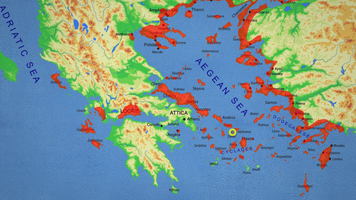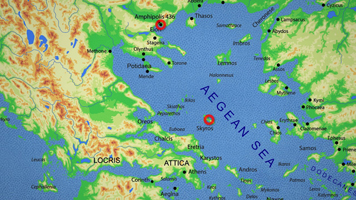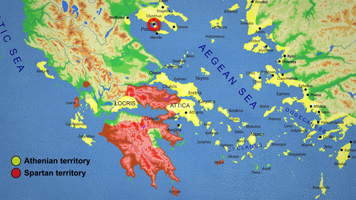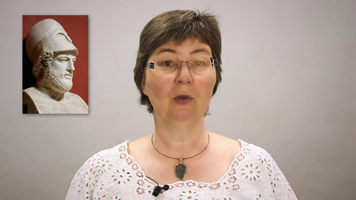Empire of the Owl: Athens‘ Rise to Superpower with the Treasure of the Delian League and its Defeat against Sparta
Once again, everybody is talking about the drachm. That’s not new. Nearly 2,500 years ago everybody was talking about the drachm, when the thalassocracy of Athens tried to control their empire through monetary measures.
In 483 BC, Athens had all the revenues obtained from the rent of a newly found silver mine in Laurion minted into tetradrachms to pay for the building of 200 triremes ? 200 triremes that were to make Athens the leading naval power in the Greek world as a result of the Battle of Salamis only a few years later.

Prior to Athens, no state had pursued anything that we would call a monetary policy. When important commercial cities like Aegina, Corinth and of course Athens began to adopt the coin as a new invention from Asia Minor, those objects were probably not first and foremost intended for the trade. Yet, the citizens were self-sufficient and produced their own food on their near-by farms. Therefore, the new silver coins were not used for daily shopping. And they also were only rarely employed in the long-distance trade. They were rather used as a standard and as a means to balance the different values of goods.
Yet those new coins were highly suitable for two things: first, they made it possible to store wealth in a non-perishable form. Second, with its coins, a city disposed of the ideal means to pay for all its infrastructure projects.
Thus, in 483 BC, Athens had all the revenues obtained from the rent of a newly found silver mine in Laurion minted into tetradrachms to pay for the building of 200 triremes – 200 triremes that were to make Athens the leading naval power in the Greek world as a result of the Battle of Salamis only a few years later.
In this capacity, Athens gathered all those cities that were afraid of a new Persian attack in the Delian League. This ancient equivalent to the modern NATO was founded in 478. Athens assumed leadership of the roughly 160 members. The regular meetings took place at Delos where the treasury was kept, too. All members were obliged to make a reasonable contribution to the common fight. According to size and means, they could contribute by adding a ship to the fleet or by paying cash to the benefit of those who had contributed with ships. Athens owned the majority of the ships in the fleet of the Delian League, which means that it was the treasury’s main beneficiary.

The approach was successful. In 476, the city of Eion, held by the Persians, was recaptured. In 470, Scyros was taken. In the same year, the Delian League prevailed in the naval battle of the Eurymedon.
470 BC was the year when Athens started to use the fleet of the Delian League not only against the Persians but against its own competitors as well. Athens forced the rich commercial city of Carystos on Euboea to become a member of the League. In 463, it deployed the fleet to conquer Thasos that had tried to defect from the League. At about the same time, Athens likewise gained control over the island of Aegina.
Athens had a good grip on its confederates. Officially relocating the League’s treasury from Delos to Athens in 454 was thus an easy thing to do. It allowed the Athenian politicians complete access to the common means. Naturally, they used them to fund their own projects; projects that were not remotely connected with the defense against the Persians.
From this treasury Athens funded the erection of the Parthenon and the Propylaia, the chryselephantine statue made by Phidias and the Theseion on the Agora, the Temple of Poseidon at Cape Sounion, and much, much more.
Athens allowed its average citizen to likewise participate in the riches from abroad. Everybody contributing to democracy was rewarded with money. Not with tetradrachms, of course, but with small obols. Athens created the first comprehensive system of small change in the Western world. The reason is as follows:
In the 5th century, Athens had become too big for autarky. The community was based on the division of labor, with large quantities of circulating money making it possible to do without any state intervention in the distribution of food. To make this community work, the fractions the city of Athens issued were much more important than the large tetradrachms.
The confederates paid for the luxurious lifestyle in Athens. They certainly did not like it. Yet, Athens had gained so much more power than most of the other cities that there was hardly any chance of not doing it.
The tetradrachms with the head of Athena on the obverse and the owl on the reverse were omnipresent in the Greek world. Apparently, Athens even attempted to impose its own coins on its allied city-states. We have fragments of a decree from Athens that prohibited other cities from minting their own coins. This decree is highly controversial amongst scholars. The crucial line reads: “If anyone coins silver money in the cities and does not use Athenian coins or measures or weights but foreign coins and measures and weights, I will vote the penalty and punishment in accordance with the previous decree moved by Klearchos.” Does this mean that the cities were only allowed to mint coins in the same weight as the ones from Athens? Were there any exceptions? Does the decree really date to 440 BC? Or is it referred to in the play ‘Birds’ written by Aristophanes and presented in 414? There, the Seller of Decrees proclaims that “the people of Cloudcuckooland shall use the same measures, weights and coinage as the Olophyxians.” These few lines already illustrate the complexity of the coinage decree’s reading.
There is one thing, though, all scholars agree upon: that Athens had become a ruthless imperial power in the second half of the fifth century.

Of course, the subjects did not accept that forever. There was always Sparta as an alternative to Athens. And finally, Sparta took the decision to start a war and stop Athens. The catalyst for the Peloponnesian War was Potidaea, a small city located in Northern Greece. Sparta promised to provide military assistance if Potidaea would defect the Delian League.
This incident led to the war. Athens was not worried at all, with so much money stored in the treasure chest. Thucydides reports about how Pericles calmed the excited Athenians in the popular assembly down. He said that “war was mostly won on intelligence and a reserve of money. And he told them to take courage, since about six hundred talents of tribute a year came into the city, apart from other revenue, and that there were still at that time six thousand talents of coined money on the acropolis. This sum did not include the uncoined gold and silver contained in private and public dedications, the holy regalias for processions and the games, the Persian booty, and other such, which came to not less than five hundred talents. Moreover, the possessions from other temples added not a little that they might use and, if they were forced to do it, they could avail themselves of the gold of the goddess herself. … In this way, he encouraged them about their financial resources.”
But Pericles was mistaken. Athens’s resources were depleted when Sparta and its allies started laying siege on the city in 405. In 404, Athens was forced to surrender. It was stripped of its walls, all of its ships except for twelve and its oversea possessions. That was the end of the thalassocracy of Athens, although many a politician kept dreaming of regaining its former position of power one again.
